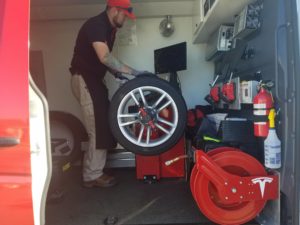Reliable Flat Tire Repair Las Vegas - Mobile Help
Reliable Flat Tire Repair Las Vegas - Mobile Help
Blog Article
Tire Service: Proven Approaches for Ideal Tire Maintenance and Treatment
Keeping optimal tire problem is extremely important for both security and performance of any kind of automobile. From guaranteeing proper tire pressure to normal rotation and positioning, there are tested techniques that can dramatically expand the life expectancy of your tires and improve total driving experience. As we check out the ins and outs of tire care and maintenance, we will certainly uncover crucial guidelines that every vehicle owner need to stick to for the ideal possible results. Let's look into the world of tire solution and find the secrets to keeping your tires in top-notch form for the lengthy haul.
Relevance of Tire Pressure
Adequate tire stress promotes much better gas effectiveness, as under-inflated tires can lead to raised rolling resistance, causing the engine to function more difficult and eat even more fuel. Appropriate tire stress ensures even tread wear, improving tire long life and conserving cash in the long run by postponing the requirement for premature replacements. Consistently checking and changing tire stress, specifically previously long trips, is a basic yet efficient means to enhance lorry efficiency, extend tire life-span, and focus on security on the roadway.
Tire Turning Guidelines
When thinking about tire turning standards, it is necessary to recognize the significance of this upkeep job in optimizing tire life expectancy and preserving optimum automobile performance. Tire turning entails changing the position of each tire on an automobile to make certain even walk wear. Front tires tend to put on faster than back tires because of steering forces, making regular turning vital for well balanced wear patterns. The advised turning pattern varies depending upon whether a car is front-wheel, rear-wheel, all-wheel, or four-wheel drive. Generally, tires need to be revolved every 5,000 to 7,500 miles, or as advised in the lorry handbook. Disregarding tire turning can lead to irregular wear, affecting handling, traction, and possibly compromising vehicle safety and security. By sticking to correct rotation guidelines, motorists can extend the life of their tires, boost fuel performance, and improve general driving experience. Routine turning is an easy yet reliable maintenance practice that adds considerably to tire durability and lorry efficiency.

Advantages of Wheel Alignment
Ensuring appropriate wheel placement after tire turning is crucial for keeping balanced wear patterns and taking full advantage of vehicle efficiency. Wheel positioning refers to the modification of the angles of the wheels to the supplier's requirements. One of the crucial benefits of wheel positioning is improved dealing with look at here now and steering reaction. When the wheels are correctly lined up, it reduces steering initiative, ensuring a smoother and much more regulated driving experience. In addition, proper wheel alignment aids to extend the lifespan of your tires. Misaligned wheels can cause uneven tire wear, resulting in premature tire replacement and enhanced upkeep expenses.

Tire Footstep Deepness Examine
Doing a normal examination of tire step depth is vital for maintaining safe driving navigate to this website conditions and extending the life-span of your tires. The step on your tires plays a vital duty in supplying traction, specifically in wet or unsafe conditions. To check your tire tread depth, you can utilize a tread depth gauge or the dime examination. The recommended walk deepness goes to the very least 2/32 of an inch. If the tread deepness is listed below this threshold, it is time to replace your tires to guarantee ideal performance and security when driving. Unequal tread wear can suggest issues with tire placement, stress, or suspension, highlighting the importance of normal tread depth checks. Neglecting to check and maintain appropriate step deepness can lead to minimized grasp, longer braking ranges, and a boosted danger of hydroplaning. By incorporating tire walk deepness look into your routine upkeep routine, you can drive with self-confidence knowing that your tires are in leading condition.
Seasonal Tire Assessment
Seasonal tire inspection is a fundamental aspect of tire maintenance that ensures tires are all set to deal with the difficulties postured by different weather condition conditions. In preparation for wintertime, it is crucial to examine the tire stress consistently as cool temperatures can create tire stress to drop. By performing regular seasonal tire evaluations, drivers can lengthen tire life-span, boost gas effectiveness, and most significantly, make certain a safe driving experience in varying climate conditions.
Final Thought
In final thought, maintaining correct tire stress, revolving tires routinely, straightening wheels correctly, monitoring my review here step deepness, and performing seasonal examinations are essential methods for optimal tire treatment. By complying with these confirmed techniques, drivers can guarantee their tires last much longer, execute far better, and add to total vehicle security. It is essential to prioritize tire upkeep to stop accidents, boost fuel performance, and lengthen the life-span of tires.
Sufficient tire pressure promotes far better fuel effectiveness, as under-inflated tires can lead to boosted rolling resistance, triggering the engine to function tougher and consume even more fuel.When thinking about tire turning guidelines, it is important to comprehend the significance of this maintenance job in making the most of tire life-span and maintaining optimal lorry efficiency. Seasonal tire assessment is a basic element of tire upkeep that makes certain tires are prepared to face the difficulties presented by different weather condition conditions. By conducting routine seasonal tire assessments, motorists can lengthen tire lifespan, improve gas effectiveness, and most importantly, ensure a secure driving experience in varying weather condition problems.
In conclusion, keeping correct tire stress, turning tires frequently, straightening wheels appropriately, keeping track of tread depth, and carrying out seasonal evaluations are vital practices for optimal tire care.
Report this page